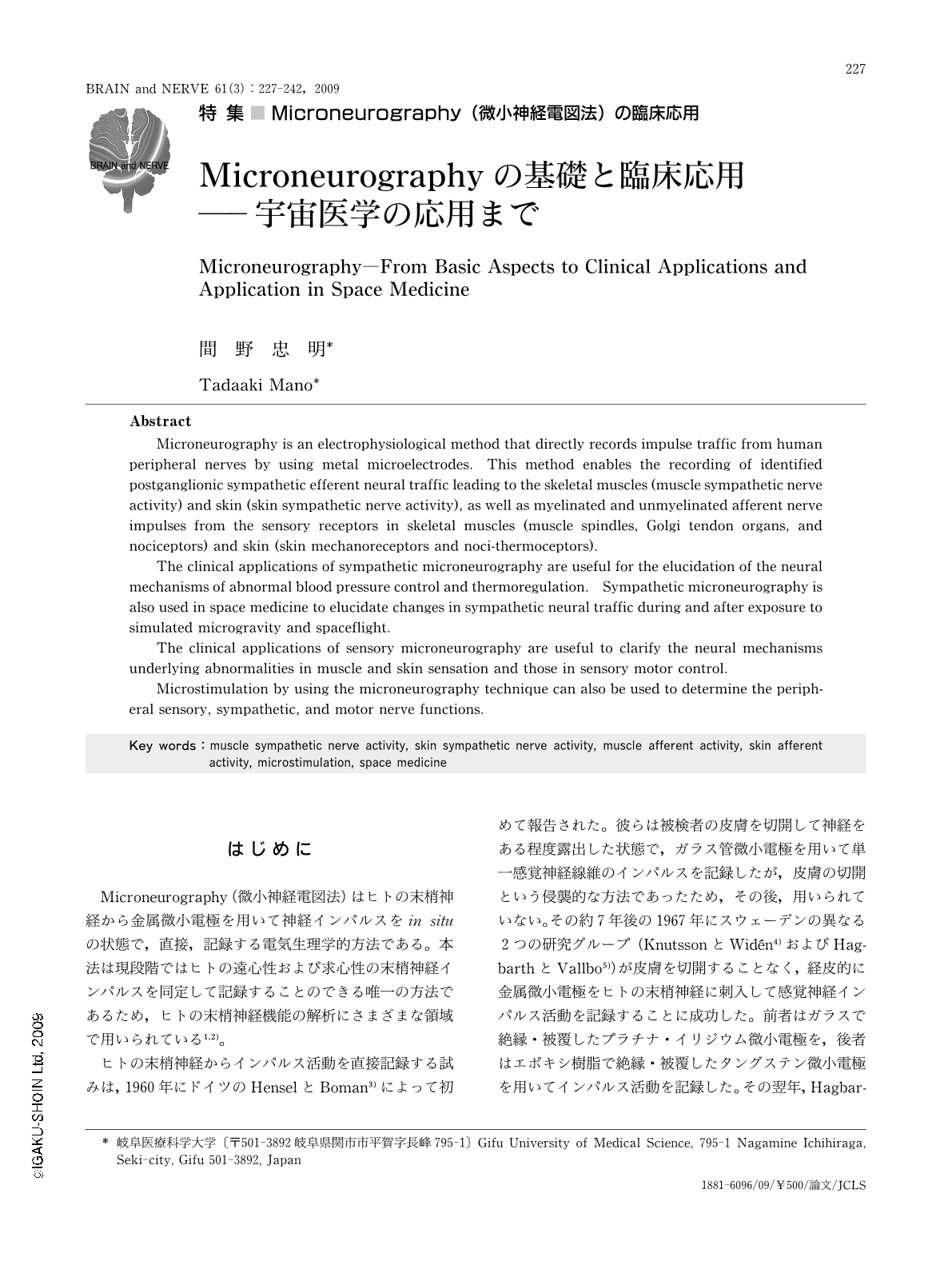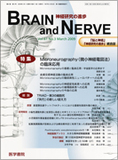Japanese
English
- 有料閲覧
- Abstract 文献概要
- 1ページ目 Look Inside
- 参考文献 Reference
はじめに
Microneurography(微小神経電図法)はヒトの末梢神経から金属微小電極を用いて神経インパルスをin situの状態で,直接,記録する電気生理学的方法である。本法は現段階ではヒトの遠心性および求心性の末梢神経インパルスを同定して記録することのできる唯一の方法であるため,ヒトの末梢神経機能の解析にさまざまな領域で用いられている1,2)。
ヒトの末梢神経からインパルス活動を直接記録する試みは,1960年にドイツのHenselとBoman3)によって初めて報告された。彼らは被検者の皮膚を切開して神経をある程度露出した状態で,ガラス管微小電極を用いて単一感覚神経線維のインパルスを記録したが,皮膚の切開という侵襲的な方法であったため,その後,用いられていない。その約7年後の1967年にスウェーデンの異なる2つの研究グループ(KnutssonとWiden4)およびHagbarthとVallbo5))が皮膚を切開することなく,経皮的に金属微小電極をヒトの末梢神経に刺入して感覚神経インパルス活動を記録することに成功した。前者はガラスで絶縁・被覆したプラチナ・イリジウム微小電極を,後者はエポキシ樹脂で絶縁・被覆したタングステン微小電極を用いてインパルス活動を記録した。その翌年,HagbarthとVallbo6)はヒトの交感神経活動の初めての記録を報告した。その後,タングステン微小電極を用いたHagbarthとVallboの方法が発展し,現在microneurographyと呼ばれる方法の原法となった。
Microneurographyの発展を目的として,1988年にわが国でニューログラム研究会が発足した。この研究会はさまざまな領域の研究者を含む学際的集会であり,これまでに21回の研究会が開催され,測定法,研究成果などについての発表とともに,本法実施のためのガイドラインの作成,倫理的問題の検討など活発になされている。研究発表にはロボット工学への応用(満淵邦彦,鈴木隆文,他),人工臓器制御への応用(山家智之,他),血糖制御への応用(中村孝夫,他)など,極めてユニークな目的を持つものも含まれている。第20回ニューログラム研究会は2007年10月8日に,第5回国際自律神経科学会議(ISAN2007)のサテライトシンポジウム“Microneurography as a potent tool of autonomic testing in humans”との共催で京都で開催された。これに先立ち本法のハンズオンセミナーが開かれ,研究会のメンバー(國本雅也,岩瀬 敏,新藤和雅,長谷川 修)が国内外の研究者に新しい測定装置などを用いた記録法の実際を供覧した。
Abstract
Microneurography is an electrophysiological method that directly records impulse traffic from human peripheral nerves by using metal microelectrodes. This method enables the recording of identified postganglionic sympathetic efferent neural traffic leading to the skeletal muscles (muscle sympathetic nerve activity) and skin (skin sympathetic nerve activity), as well as myelinated and unmyelinated afferent nerve impulses from the sensory receptors in skeletal muscles (muscle spindles, Golgi tendon organs, and nociceptors) and skin (skin mechanoreceptors and noci-thermoceptors).
The clinical applications of sympathetic microneurography are useful for the elucidation of the neural mechanisms of abnormal blood pressure control and thermoregulation. Sympathetic microneurography is also used in space medicine to elucidate changes in sympathetic neural traffic during and after exposure to simulated microgravity and spaceflight.
The clinical applications of sensory microneurography are useful to clarify the neural mechanisms underlying abnormalities in muscle and skin sensation and those in sensory motor control.
Microstimulation by using the microneurography technique can also be used to determine the peripheral sensory,sympathetic,and motor nerve functions.

Copyright © 2009, Igaku-Shoin Ltd. All rights reserved.


